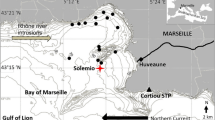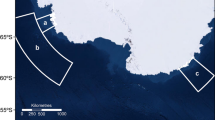Abstract
Diet composition of nine commercially exploited fishery resources which contributes 55–60% of the total fish landings in the northwest coast of India were analyzed in this study. Gut content analysis of the selected fish groups has shown significant variations in the prey composition and predator preference on a prey item. The diet matrix revealed Acetes sp. (32.74%) as a key and common shared prey item, followed by mesopelagic fishes (30.51%), other shrimps (11.00%), digested material (7.42%), crabs (4.03%) and cephalopods (2.77%), etc. In this study, Acetes sp was considered as a proxy for the non-penaeid prawns due to its significant contribution (92%) to the total non-penaeid landings. Targeted exploitation of Acetes sp. has intensified recently (from 0.44 lakh t in 2004 to 1.40 lakh t in 2018) with an average annual growth rate of 11.2% due to the demand from fish meal plants. By considering its ecological and fishery importance, Acetes sp. should be considered as keystone species in the ecosystem. The Schaefer surplus production model was used to calculate the Biological Reference Points (BRPs) and model parameters MSY, FMSY, r, EMSY, and K. The model fit was fair (R2 = 0.630) and significantly positive correlation was observed between CPUEobserved and CPUEmodel. The estimated optimum exploitation limits (p < 0.05) for the fishery were Maximum Sustainable Yield (MSY) as 1.20 lakh t and fishing effort required to harvest MSY (EMSY) as 51.30 lakh fishing hours. However, the recent exploitation yield and fishing effort are beyond the optimum exploitation limits. Further increase in exploitation of the resources may hamper the sustainability of the stocks and may lead to detrimental impact on the trophic interactions of the fishery resources. Technical interventions are needed in the field of post-harvest and value addition for attaining fair economic returns from the harvest which at present forms a low-value high-volume fishery. Sustainable exploitation and management measures need to be introduced and implemented for the Acetes sp. in order to sustain the stocks and to maintain the integrity of the fishery ecosystem.








Similar content being viewed by others
References
Abdussamad EM, Koya KP, Ghosh S, Rohit P, Joshi KK, Manojkumar B, Prakasan D, Kemparaju S, Elayathu MNK, Dhokia HK, Sebastine M (2012) Fishery, biology and population characteristics of longtail tuna, Thunnus tonggol (Bleeker, 1851) caught along the Indian coast. Indian J Fish 59(2):7–16
Balan K, Sathianandan TV (2007) An assessment of ring seine fishery in Kerala through surplus production model. Indian J Fish 54(2):135–140
Clarke KR (1993) Non-parametric multivariate analyses of changes in community structure. Austral Ecol 18:117–143
CMFRI (2019) Annual Report 2018–19. Central Marine Fisheries Research Institute, Kochi
De Sousa SN, Kumar MSD, Sardessai VVSS, Shirodkar PV (1996) Seasonal variability in oxygen and nutrients in the central and eastern Arabian Sea. Curr Sci 71(11):847–851
Deshmukh VD (1991) Utilisation of paste shrimp Acetes: a review. Mar Fish Info Ser Tech Ext Ser 110:7–8
Deshmukh VD (1993) Status of non-penaeid prawn fishery of India and stock assessment of Acetes indicus Milne Edwards off Maharashtra. Indian J Fish 40(1&2):50–62
Deshmukh VD (2004) Non-penaeid prawns. In: Status of exploited marine fishery resources of India. CMFRI, Cochin, pp 183–187
Ghosh S (2014) Fishery, reproductive biology and diet characteristics of Bombay duck Harpadon nehereus from the Saurashtra coast. Indian J Geo-Mar Sci 43(3):418–426
Ghosh S, Rao MVH, Rohit P, Rammohan K, Maheswarudu G (2014) Reproductive biology, trophodynamics and stock structure of ribbonfish Trichiurus lepturus from northern Arabian Sea and northern Bay of Bengal. Indian J Geo-Mar Sci 43(5):755–771
Golani D, Galil B (1991) Trophic relationships of colonizing and indigenous goatfishes (Mullidae) in the eastern Mediterranean with special emphasis on decapod crustaceans. Hydrobiol 218:27–33
Griffiths SP, Fry GC, Manson FJ, Pillans RD (2007) Feeding dynamics, consumption rates and daily ration of longtail tuna (Thunnus tonggol) in Australian waters, with emphasis on the consumption of commercially important prawns. Mar Freshw Res 58(4):376–397
Harmelin VML, Malka RAK, Ledoyer M, Abraham SSJ (1989) Food partitioning among scorpaenid fishes in Mediterranean seagrass beds. J Fish Biol 34:715–734
Horn HS (1966) Measurement of overlap in comparative ecological studies. Am Nat 100:419–424
Hughes RN (1997) Diet selection. In: Godin JCG (ed) Behavioral ecology of teleost fishes. Oxford University Press, Oxford
Jaiswar AK, Chakraborty SK (2005) Acetes, the preferred food of fishes along the north-west coast of India. Indian J Fish 52:215–219
Jaworski A, Ragnarsson SA (2006) Feeding habits of demersal fish in Icelandic waters: a multivariate approach. ICES J Mar Sci 63:1682–1694
Jayasankar J, Najmudeen TM, Najeemudeen SH, Ramani K, Beena MR, Seynudeen MB, Anandan K, Khambadkar L (2012) Marine fisheries of the north-west coast of India during 2009–2010. Mar Fish Info Ser T & E Serv 214:1–3
Kidwai S, Amjad S (2000) Zooplankton: pre-southwest and northeast monsoons of 1993 to 1994, from the North Arabian Sea. Mar Biol 136:561–571
Koya MK, Rohit P, Abdussamad EM, Pokatapada AA, Vase VK, Sangita BA (2018a) Reproductive biology, diet and feeding pattern of longtail tuna Thunnus tonggol (Bleeker, 1851) in the north-eastern Arabian Sea off Gujarat, India. Indian J Fish 65(2):16–25
Koya MK, Vase VK, Pakatapada AA, Sreenath KR, Dash G, Sangita BA, Ganesh T, Rohit P (2018b) Diet composition and feeding dynamics of Trichiurus lepturus Linnaeus, 1758 off Gujarat, north-west coast of India. Indian J Fish 65(2):50–57
Kumar R, Xavier KM, Lekshmi M, Dhanabalan V, Thachil MT, Balange AK, Gudipati V (2018) Development of functional extruded snacks by utilizing Paste shrimp (Acetes spp.): Process optimization and quality evaluation. J Sci Food Agric 98(6):2393–2401
Kurup KN, Devaraj M (1999) Estimates of optimum fleet size for the exploited Indian shelf fisheries. Mar Fish Info Ser Tech Ext Ser 165:1–11
Labropoulou M, Eleftheriou A (1997) The foraging ecology of two pairs of congeneric demersal fish species: Importance of morphological characteristics in prey selection. J Fish Biol 50:324–340
Madhupratap M, Nair KNV, Gopalakrishnan TC, Haridas P, Nair KKC, Venugopal P, Gauns M (2001) Arabian Sea oceanography and fisheries of the west coast of India. Curr Sci 81(4):355–361
Mahida PJ, Yusufzai SI, Lende SR, Ishakani AH, Kadri RM (2017) Acetes meal as a non-conventional protein ingredient to partially replace fish meal in diets of pacific white shrimp (Litopenaeus vannamei Boone, 1931). Ecol Environ Conserv 23(1):262–267
Manojkumar PP (2004) Some aspects on the biology of Nemipterus japonicus (Bloch) from Veraval in Gujarat. Indian J Fish 51(2):185–191
Marshall S, Elliott M (1997) A comparison of univariate and multivariate numerical and graphical techniques for determining inter- and intraspecific feeding relationships in estuarine fish. J Fish Biol 51:526–545
Mohanraj T, Prabhu K (2012) Food habits and diet composition of demersal marine fishes from Gulf of Mannar, Southeast Coast of India. Adv Biol Res 6(4):159–164
Morrison JM (1997) Inter-monsoonal changes in the T‐S properties of the near‐surface waters of the northern Arabian Sea. Geophy Res Lett 24(21):2553–2556
Najmudeen TM, Sathianandan TV, Zacharia PU (2014) Fleet optimization of trawl fishery along southwest coast of India using surplus production model. J Mar Biol Assoc India 56(2):74–80
Pinkas L, Oliphant MS, Iverson ILK (1971) Food habits of albacore, bluefin tuna, and bonito in California waters. California Department Fish and Game. Fish Bull 152:1–105
Platell ME, Potter IC, Clarke KR (1998) Do the habitats, mouth morphology and diets of the mullids Upeneichthys stotti and U. lineatus in coastal waters of south-western Australia differ? J Fish Biol 52:398–418
Prager MH (1994) A suite of extensions to a nonequilibrium surplus-production model. Fish Bull 92(2):374–389
Prager MH (2002) Comparison of logistic and generalized surplus-production models applied to swordfish Xiphias gladius in the North Atlantic Ocean. Fish Res 58:41–57
Ragno G, De Luca M, Ioele G (2007) An application of cluster analysis and multivariate classification methods to spring water monitoring data. Microchem J 87:119–127
Ruggieri N, Castellano M, Capello M, Maggi S, Povero P (2011) Seasonal and spatial variability of water quality parameters in the Port of Genoa, Italy, from 2000 to 2007. Mar Poll Bull 62:340–349
Sathianandan TV, Jayasankar J (2009) Managing marine fishery in Kerala through simulation using surplus production model, genetic algorithm and spectral methods. Indian J Fish 56(3):163–168
Sathianandan TV, Jayasankar J, Kuriakose S, Mini KG, George G, Karthireddy S, Vase VK, Srinivasan J, Ramani K, Pugazhendi D, Seynudeen MB, George KP, Khambadkar L, Augustine SK, Manjeesh R (2014) Status of India’s Exploited Marine Fishery Resources in 2013. Mar Fish Info Serv T&E Ser 221:1–6
Schaefer MB (1954) Some aspects of the dynamics of populations important to the management of commercial marine fisheries. Bull Inter-Am Trop Tuna Comm 1(2):27–56
Scharf FS, Juanes F, Rountree RA (2000) Predator size-prey size relationships of marine fish predators: Interspecific variation and effects of ontogeny and body size on trophic niche breadth. Mar Ecol Prog Ser 208:229–248
Solanki HU, Raman M, Kumari B, Dwivedi RM, Narain A (1998) Seasonal trends in the fishery resources off Gujarat: Salient observation using NOAA AVHRR. Indian J Mar Sci 27(3&4):438–442
Sonavane AE, Joshi VR, Koli JM (2016) Standardization of acetes sandwich preparation. Int J Food Fermen Technol 6(1):75–80
Sreekanth GB, Zacharia PU, Sathianandan TV, Thomas S, Lekshmi NM, Singh NP (2015) Combining surplus production and spectral models to define fishery management advisory - a case study using the threadfin bream fishery along Kerala coast. Indian J Fish 62(1):41–45
Stergiou KI, Fourtouni H (1991) Food habits, ontogenetic diet shift and selectivity in Zeus faber Linnaeus, 1758. J Fish Biol 39:589–603
Suseelan C (1996) Crustacean biodiversity, conservation and management. In: Menon NG, Pillai CSG (eds) Marine biodiversity and conservation management. Central Marine Fisheries Research Institute, Cochin
Thangavelu R, Anbarasu M, Zala MS, Koya MK, Sreenath KR, Mojjada SK, Shiju P (2012) Food and feeding habits of commercially important demersal finfishes off Veraval coast. Indian J Fish 59(4):77–87
Wu M, Wanga Y, Sun C, Wang H, Dong J, Yin J, Han S (2010) Identification of coastal water quality by statistical analysis methods in Daya Bay, South China Sea. Mar Poll Bull 60:852–860
Zynudheen AA, Ninan G, Sen A, Badonia R (2004) Utilization of trawl bycatch in Gujarat (India) NAGA. WorldFish Quat 27(3 & 4):20–23
Acknowledgements
The authors are thankful to the Indian Council of Agricultural Research (ICAR), Director, ICAR-CMFRI and Head, Fishery Resources Assessment Division, CMFRI, Cochin for the encouragement during the study period. The work is carried out with the research fund available with the Indian Council of Agricultural Research-Central Marine Fisheries Research Institute.
Author information
Authors and Affiliations
Corresponding author
Ethics declarations
Conflict of Interest
The authors declare that they have no conflict of interest.
Rights and permissions
About this article
Cite this article
Vase, V.K., Koya, M.K., Dash, G. et al. Acetes as a Keystone Species in the Fishery and Trophic Ecosystem Along Northeastern Arabian Sea. Thalassas 37, 367–377 (2021). https://doi.org/10.1007/s41208-020-00276-y
Received:
Revised:
Accepted:
Published:
Issue Date:
DOI: https://doi.org/10.1007/s41208-020-00276-y




